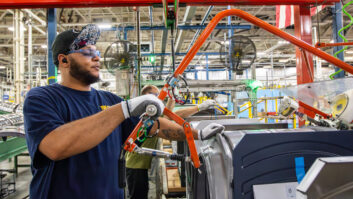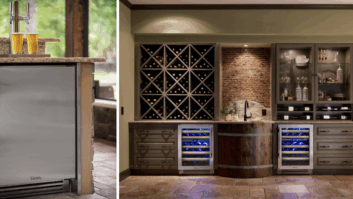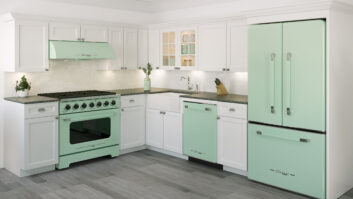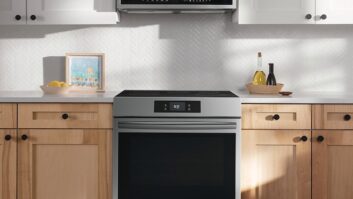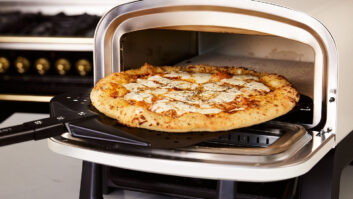New York — When TWICE initiated coverage of major appliances back in October 1990, the white-goods business was a far different animal from what it is today
At the time, the industry was in the midst of a down cycle, although truth be told, it was often difficult to differentiate between good times and bad. Indeed, if one were to draw an analogy between stocks and bonds, and consumer electronics and appliances, CE, with its wild sales and margin gyrations, would have represented equities, while white goods would have been the boring but dependable debt securities.
That’s because until recently there was little to set one SKU apart from the next, at least from the outside. Dealers’ sales teams could talk a good game of mechanical feature sets in an effort to trade customers up, but for most shoppers, stepping into a majap showroom was like wading into an undifferentiated sea of white. Vendors even touted their white-on-white color schemes.
Even still, the aptly named white-goods category provided a lifeline for CE merchants who were harder hit by declines in electronics in 1990 and needed to balance their product portfolios. As TWICE founding editor Bob Gerson wrote in his Oct. 1, 1990, Viewpoint column, announcing our expanded coverage, “The flattening demand for flagship electronics products in our temporarily saturated market has meant that many dealers have added white goods in one or more categories as a way to keep store traffic and volume up. So as they broaden their base, we broaden ours.”
The timing, however, was less than auspicious, as industry prognosticators were envisioning a somber fourth quarter ahead. The assessment was based on slow housing starts and existing home sales stemming from high mortgage and interest rates and tighter credit in the wake of the Savings and Loan scandal.
Consumer confidence was also shaken following Iraq’s invasion of Kuwait that August, and both consumers and vendors were concerned that rising oil prices would impact disposable income and manufacturing costs.
This led to Whirlpool projecting a 5 percent to 7 percent decline in industry shipments for the balance of the year, and GE anticipating soft sales for the foreseeable future. “We were saying things would be essentially flat for 1990 and for 1991, and we now think it will be a point or two worse,” said Bruce Enders, then worldwide product management and marketing VP of GE.
On the retail side, dealers reported sell-through was equally sluggish. “We’re having a tougher and tougher time selling unsealed burners,” lamented future Best Buy exec and Circuit City CEO Phil Schoonover, who, as VP/general merchandise manager of Tops Appliance City in New Jersey, was contending with flat range sales.
Looking back, vendors and retailers concede that they were feeding into the commodity mindset by trading down the business with deep discounts and an opening price-point focus. The top stories from TWICE’s earliest appliance sections included word of a new derivative Estate line developed by Whirlpool for the mass-market channel, and a spate of “heavier-than-usual” consumer promotions and dealer incentives to help jump-start sales.
“Rebates, premiums and special pricing — along with a barrage of national and local advertising — are being used to counteract the economic uncertainties that have depressed white-goods volumes in recent months,” wrote TWICE’s then-appliance editor Cathy Ciccolella.
Retailers were equally aggressive. As Thanksgiving approached, Sun TV let loose with frequent TV spots, daily full-page newspaper ads and 60-page mailers, TWICE reported, while North Shore Refrigeration was giving away free turkeys with each range purchase.
Meanwhile, manufacturers cranked out more indistinguishable white boxes. “We’re managing the development of KitchenAid laundry products with the same view we’ve taken over the past 42 years with our dishwasher products — improvements and refinements that are evolutionary rather than revolutionary,” a merchandising manager proudly told TWICE.
Yet the first stirrings of the appliance design revolution that was to come also began to surface around this time. Despite KitchenAid’s conservative pronouncements, the company opened a new industrial design center that December that brought design, market research and product training functions under one roof, with the goal of speeding product development and enhancing sensitivity to consumer needs.
Similarly, GE showed a renewed attention to cosmetics with its 1990 laundry line, which offered bolder graphics and colors and “a new, upscale appearance.” As marketing planning manager Kenneth Pritchett explained, “As laundry products move out of the basement and into more trafficked areas of the home, consumers want a sleek and aesthetically pleasing look.”
At the same time, dealers began enhancing the shopping experience by employing, among other merchandising concepts, live product demos. “We think having the unit hooked up live makes all the difference in selling a product like this,” said Bill Vandegrift, principal of an eponymous independent Amana dealership in Pennsylvania.
Sixteen years later, appliances have become a full-fledged fashion statement thanks to the advent of affordable commercial- and custom-look home appliances, and innovative front-load washer and bottom-mount refrigerator designs. As a result, pricing has firmed and then some, with mass-market laundry pairs and French door fridges approaching a $2,000 price point.
And, in a dream come true for the industry, consumers are no longer waiting 10 or 15 years for their white goods — and blue goods and green goods and stainless goods — to wear out before replacing them.




